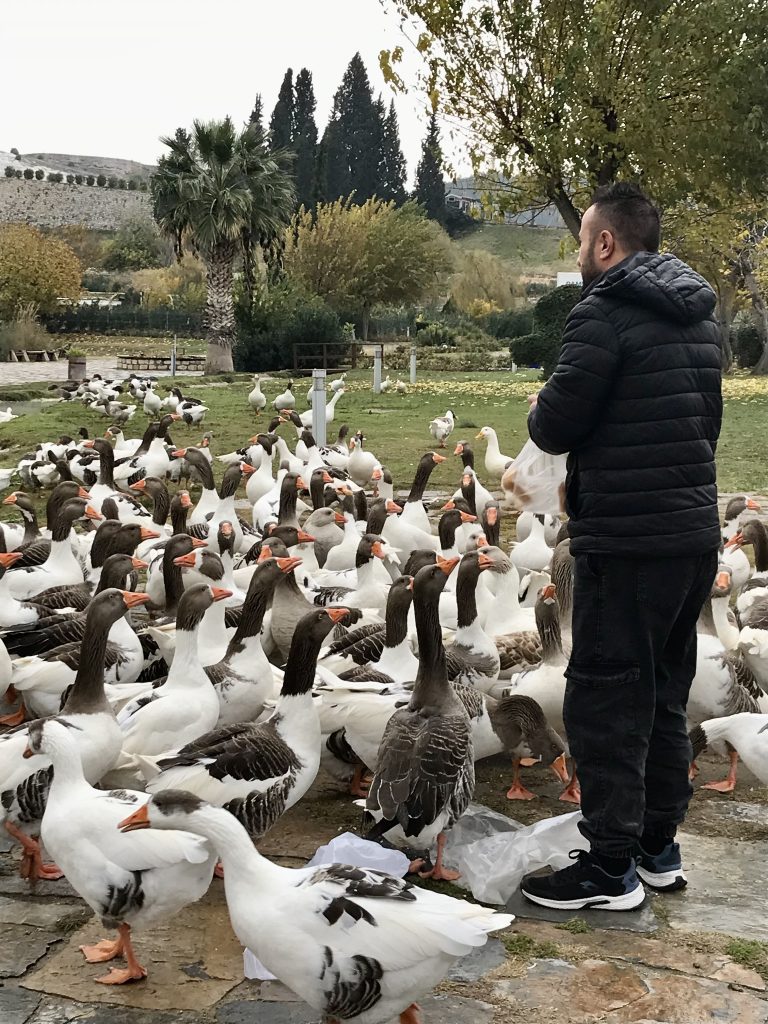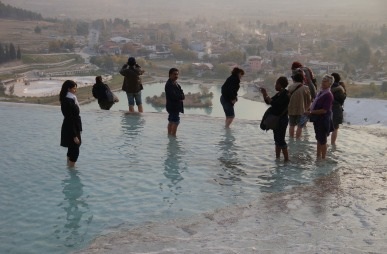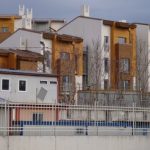“Cotton Castle” Population: 1,850
As the bus trundles into Pamukkale from Denizli passengers are rewarded with a remarkable sight. A curve of solid white is cut into the hillside for all the world as if some passing pastry cook had scooped it out, poured sugar icing over it, then patted it down, smoothed it over and pressed her fingers into it leaving hollows which could be filled in with blue. These are the famous travertines which, along with the ruins of the Roman town of Hierapolis above them, have landed Pamukkale UNESCO world heritage site status, and it’s a rare visitor to the country who does not have the site pencilled in on their itinerary.
For the non-scientists amongst us, Wikipedia defines a travertine as a form of limestone deposited by mineral springs, especially of the hot variety, and cites other examples in destinations as varied as the Yellowstone National Park in the USA and Badab-e Surt in Iran. Pamukkale is not unique, then although it is the only place where the travertines come paired with spectacular ancient ruins. Indeed, for some people the remains of Hierapolis, scattered across the hillside, may prove more exciting even than the travertines themselves.
Over the last two decades much has been done to improve the presentation of Pamukkale, including tearing down a string of motels which used to perch on the ridge and creating a small lake at the foot of it. This is a considerable plus for the village, with roses growing in a small park and a path running round the edge of a lake which is increasingly full of ducks and geese more than happy to swallow that last piece of bread left over from breakfast.
The site can now be accessed via two separate entrances several km apart. Which you should use depends mainly on your primary interest: if it’s the travertines, you should aim to walk up the ridge and enter from the pedestrian entrance near Pamukkale village; if you’re more interested in the ruins of Hierapolis. you should take the bus towards Karahayıt, and use the northern entrance which wends its way gradually through an enormous necropolis and along the ancient Frontinus Street to the travertines. It’s a two-km walk unless you hop the shuttle bus that does the loop every 15 minutes.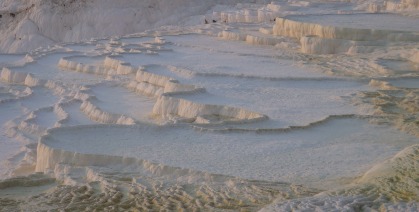
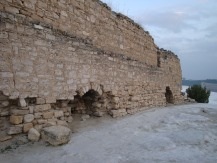
Hierapolis
The city of Hierapolis (“Sacred City”) is thought to have been founded c.190 BC by King Eumenes II of Pergamum and flourished right through the early Byzantine era until it fell on hard times in the seventh and eight centuries. After that the history books are strangely silent about what was clearly such a large and impressive place, and home to a bishopric to boot. The bishopric of Hierapolis crops up in the records for the last time in 1385. After that the city may have fallen victim to a devastating earthquake or simply faded quietly away.
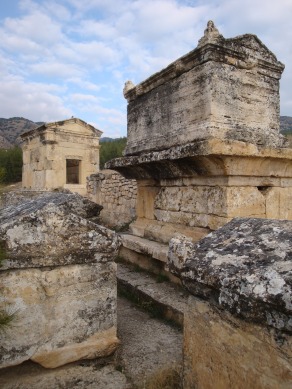 As an archaeological site, though, it has the singular advantage, like Ephesus and Aphrodisias, that it was never reoccupied, unlike for example Pergamum which evolved into the modern Bergama. This has given archaeologists a freer hand to dig up as much of the ancient town as funds permit (as they have also been able to do, for the same reason and with even more spectacular results, at nearby Laodikeia).
As an archaeological site, though, it has the singular advantage, like Ephesus and Aphrodisias, that it was never reoccupied, unlike for example Pergamum which evolved into the modern Bergama. This has given archaeologists a freer hand to dig up as much of the ancient town as funds permit (as they have also been able to do, for the same reason and with even more spectacular results, at nearby Laodikeia).
If you enter the site from the northern entrance you will find yourself wandering amid a vast necropolis where the Italian Archaeological Mission has identified four distinct styles of burial ranging from huge freestanding sarcophagi, through mini-temples to a cluster of tombs that resemble tumuli (burial mounds); it has also picked out and labelled the most interesting. In between coach parties this is a quiet and awe-inspiring place that you may share only with the odd owl.
The necropolis comes to an abrupt end against the massive walls of an ancient bathhouse, later converted into a church, that stood right beside the 1st-century Arch of Domitian, itself flanked by stone towers.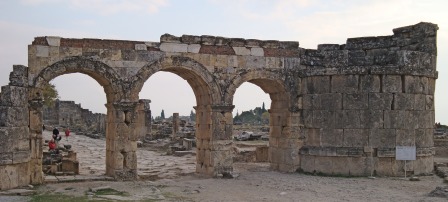
Beyond this you will have the pleasure of strolling quite literally in the (worn) footsteps of the Romans as you amble along what was once the mile-long Frontinus Street, named after the then proconsul of Asia. Romans popping to and from the necropolis would have paused to relieve themselves first at a communal latrine just beside the arch, which was later turned into a storage depot.
Frontinus Street leads to the site of an agora (market place) that was once one of the largest in the Roman world. Disappointingly little now remains of it since much of the stonework seems to have been reused when walls were built round the city in the fifth century.
That is certainly not true of the enormous theatre, probably built high up on the hillside in the 2nd century and then destroyed by an earthquake in the 7th century. Its restoration has included reconstructing the old stage backdrop. By fencing the stage off the authorities have also ensured that visitors are able to appreciate the beauty of the finished work. 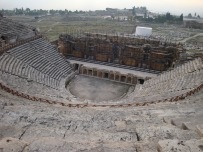
By the time you reach this point your energy may be starting to flag but it’s still worth cutting across the hillside to visit the unusual octagonal martyrium built in the fifth century on the site where it’s believed that St Philip the Apostle was crucified upside down in around 80 AD (in fact it may have been a completely different saint, Philip the Deacon).
Italian archaeologists have now uncovered a Byzantine church downhill from the martyrium that appears to incorporate the burial place of St Philip. The martyrium and church used to be approached via an impressive flight of stone steps that also survives along with the relics of a bathhouse where they could wash before continuing their pilgrimage.
Turning back down the hill you will be able to admire the remains of a truly enormous nymphaeum (public fountain) overlooking a second agora. Behind it stand the remains of a Temple of Apollo as well as the curious Plutonium, a spring that used to emit fumes so poisonous that it would kill the small animals and birds routinely tossed into it by heartless priests.
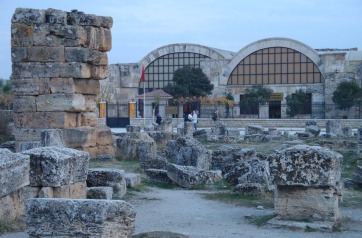 Pamukkale MuseumFinally you will reach what is really the heart of the site at Pamukkale: a disappointingly featureless piece of land with, to one side, another large bathhouse that managed to survive the vicissitudes of history almost intact, perhaps because it was reused as an administrative centre; today it houses an impressive small museum where you can find a fine collection of sarcophagi as well as some of the carvings that used to decorate the theatre. Here, too, are the finds from the Beycesultan mound near Çivril.
Pamukkale MuseumFinally you will reach what is really the heart of the site at Pamukkale: a disappointingly featureless piece of land with, to one side, another large bathhouse that managed to survive the vicissitudes of history almost intact, perhaps because it was reused as an administrative centre; today it houses an impressive small museum where you can find a fine collection of sarcophagi as well as some of the carvings that used to decorate the theatre. Here, too, are the finds from the Beycesultan mound near Çivril.
Don’t leave without inspecting the overflow collection in the grounds that includes some magnificent capitals decorated with sphinxes and with lions devouring bulls, their eyes embedded with pieces of lapis lazuli.
Nearby is the Antique Pool, a cafe, restaurant and spa complex built around a glorious pool dotted with pieces of column from the ancient city. What could be more enjoyable than to swim over these scraps of ancient masonry while pondering the long lost past? A dip no longer comes cheap though.
Don’t fancy it? Well, these days you can also opt to have your toes nibbled by the tiny “doctor fish” that were once found only at the Balıklı Kaplıca near Sivas. It’s a curiously tickly sensation.
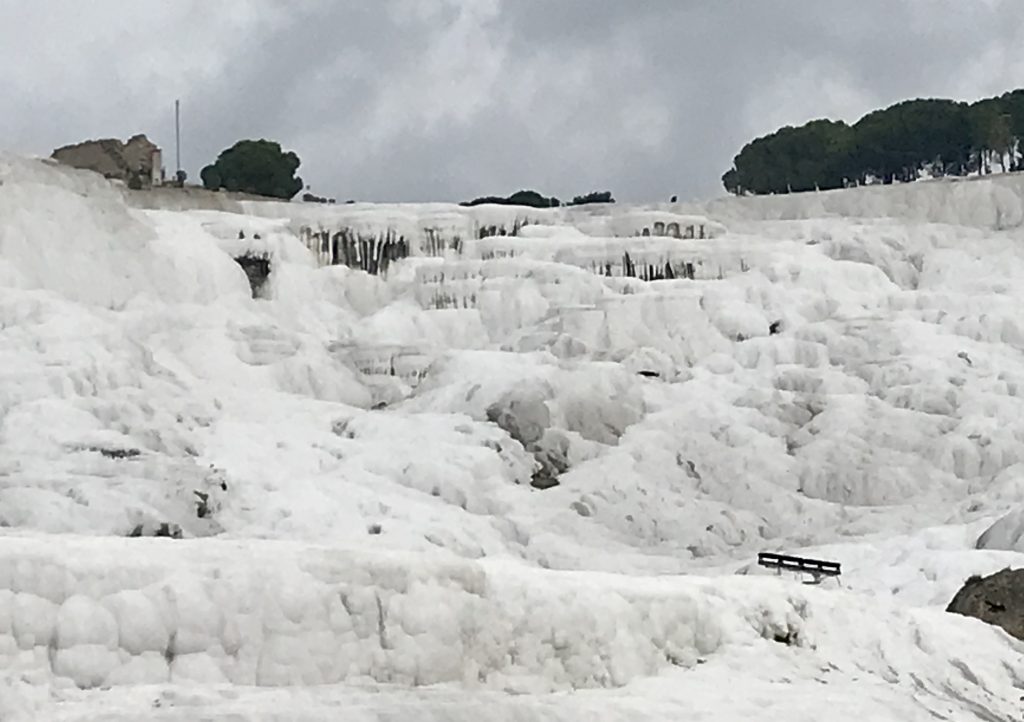
Sleeping
For many people Pamukkale is merely a whistlestop break on the road from Ephesus to Antalya. With time on your hands, though, you need to decide where best to base yourself to make the most of a visit.
There are three choices: the small village at Pamukkale itself, the thermal resort at nearby Karahayıt or the provincial capital of Denizli.
Pamukkale Köyü (Pamukkale Village)
The leafy little village at the foot of the travertines has grown up in haphazard fashion and consists mainly of a string of small family-run pensions that compete with each other for the backpacker trade. Most have pleasant gardens often with small swimming pools, the perfect places to relax at the end of a long day’s sightseeing.
A growing number of hotels catering for those with deeper pockets look a little out of place in what is essentially a small rural settlement where many locals whiz around on electric three-wheelers.
Pension owners may be able to arrange drop-offs and pick-ups from the travertines as well as excursions to other local attractions depending on how many other people are staying.
You can easily walk to the travertines from Pamukkale Köyü, and a few of the pensions boast spectacular views across the newly created lake at the bottom.
There is a small supermarket and several ATM machines in the village.
Beyaz Kale Pension. Tel: 0258-272 2064
Kervansaray Pension. Tel: 0258-272 2209
Eating
Formal restaurants struggle to make ends meet in a village whose pension owners pride themselves on their home cooking; as in Selçuk, you may be better off eating in rather than going out to dine. A growing number offer a curious mix of Turkish staples alongside Indian and Chinese dishes.
Travel info
Flights from İstanbul and Ankara serve Denizli airport.
In high season some bus companies drop passengers off in Pamukkale Köyü. Otherwise there are frequent dolmuşes from the central bus station in Denizli.
Day trip destinations
Tavas
Read about visiting Pamukkale in winter: http://www.turkeyfromtheinside.com/index.php?option=com_easyblog&view=entry&id=34&Itemid=218 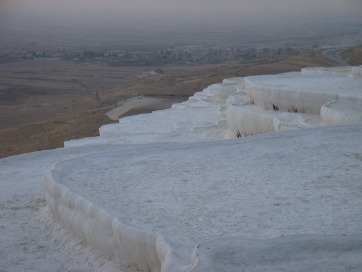
Strabo writing on the Plutonium in 1st century AD: “…for any living creature which enters inside death is instantaneous. Bulls, for example, which are taken in collapse and are brought out dead; we ourselves sent in small birds which at once fell lifeless. The eunuchs of Cybele, however, are immune to the extent that they can approach the orifice and look in, and even penetrate for some distance, though not normally without holding their breath.”
